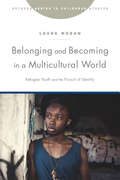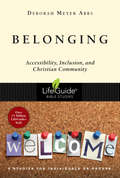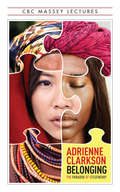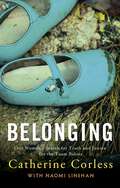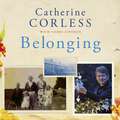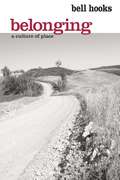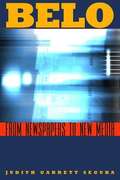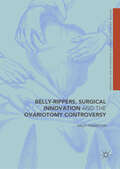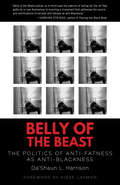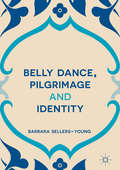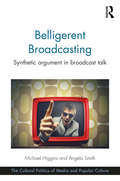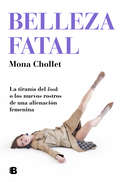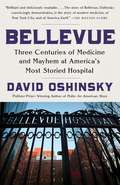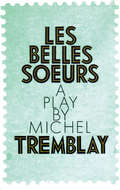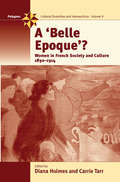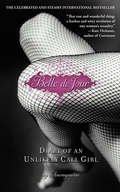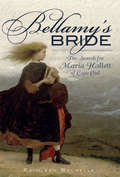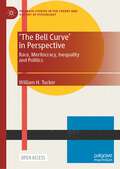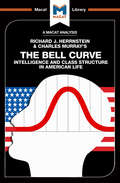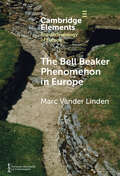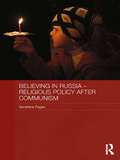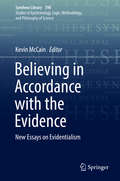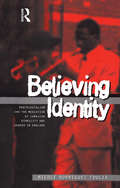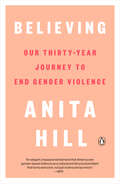- Table View
- List View
Belonging and Becoming in a Multicultural World: Refugee Youth And The Pursuit Of Identity (Rutgers Series In Childhood Studies)
by Laura MoranChildren and youth are front and center in the context of global mass migration and the social discord around questions of multicultural inclusion that it often ignites. It is young people at the forefront of navigating the complexities of cultural and ethnic diversity in their everyday lives. Imprecise portrayals of their inclination to either embrace diversity or to incite racism are used to exemplify both the success and failures of the multicultural project. In the context of young people's heightened politicization, Belonging and Becoming in a Multicultural World, shifts the focus to a group of Sudanese and Karen refugee youth's own insights, explanations and practices as they attempt to create a sense of identity and belonging. It sees these young people engaging race, racism and national identity in creative and unexpected ways as they are confronted with the social and moral implications of multiculturalism in Australia.
Belonging: Accessibility, Inclusion, and Christian Community (LifeGuide Bible Studies)
by Deborah Meyer AbbsGod created all of us for relationship with God and each other. Yet most people have felt left out at some point. For those with visible or invisible disabilities, attitudes and systems of ableism can particularly lead to deep hurt and barriers to fully participating in God's kingdom work. We all miss out when any members of the body of Christ are not included. In this nine-session LifeGuide Bible study, Deborah Abbs guides you to explore the deep love and acceptance of our heavenly Father and what it means for offering love and acceptance to one another. Through Old and New Testament stories and teachings on Christian community, we see how God responds in love to those who are often marginalized and excluded so that we too can welcome people of all different abilities. For over three decades LifeGuide Bible Studies have provided solid biblical content and raised thought-provoking questions—making for a one-of-a-kind Bible study experience for individuals and groups. This series has more than 130 titles on Old and New Testament books, character studies, and topical studies.
Belonging: The Paradox of Citizenship (The CBC Massey Lectures)
by Adrienne ClarksonNever has the world experienced greater movement of peoples from one country to another, from one continent to another. These seismic shifts in population have brought about huge challenges for all societies. In this year’s Massey Lectures, Canada’s twenty-sixth Governor General and bestselling author Adrienne Clarkson argues that a sense of belonging is a necessary mediation between an individual and a society. She masterfully chronicles the evolution of citizenship throughout the ages: from the genesis of the idea of the citizen in ancient Greece, to the medieval structures of guilds and class; from the revolutionary period which gave birth to the modern nation-state, to present-day citizenship based on shared values, consensus, and pluralism. Clarkson places particular emphasis on the Canadian model, which promotes immigration, parliamentary democracy, and the rule of law, and the First Nations circle, which embodies notions of expansion and equality. She concludes by looking forward, using the Bhutanese example of Gross National Happiness to determine how we measure up today and how far we have to go to bring into being the citizen, and the society, of tomorrow.
Belonging: A Memoir of Place, Beginnings and One Woman's Search for Truth and Justice for the Tuam Babies
by Catherine CorlessONE WOMAN, THE SECRETS OF A SMALL TOWN, AND A QUEST FOR JUSTICE THAT ROCKED A NATION. Catherine Corless could not have known where her interest in local history would lead her, as she began researching the Tuam Mother and Baby Home in Galway in 2010. Uncovering no less than 796 missing burial records of children born there, the stark truth of their place of rest became clear: a disused sewage tank on the old home site, where two boys had once stumbled upon bones. But who were these lost children, and what had happened to them in the care of the Bons Secours order of nuns? Determined to know more, Catherine's painstaking research led to a quest for justice that continues still as, often against fierce resistance, she brought to light a terrible truth that shocked the world, impacted the Vatican, and led to a Commission of Investigation in Ireland. Part memoir, part detective story, Belonging is both a personal account - of identity, beginnings and Catherine's search for her own mother's lost story - and a recounting of her forensic crusade on behalf of the lost babies of Tuam. It speaks to the tender love of a mother and her child; to the unforgettable screams which echoed through the corridors as babies were taken against the parent's will; and to a mystery which continues to this day, as so many still search to know where, and to whom, they belong.
Belonging: A Memoir of Place, Beginnings and One Woman's Search for Truth and Justice for the Tuam Babies
by Catherine CorlessONE WOMAN, THE SECRETS OF A SMALL TOWN, AND A QUEST FOR JUSTICE THAT ROCKED A NATION. Catherine Corless could not have known where her interest in local history would lead her, as she began researching the Tuam Mother and Baby Home in Galway in 2010. Uncovering no less than 796 missing burial records of children born there, the stark truth of their place of rest became clear: a disused sewage tank on the old home site, where two boys had once stumbled upon bones. But who were these lost children, and what had happened to them in the care of the Bons Secours order of nuns? Determined to know more, Catherine's painstaking research led to a quest for justice that continues still as, often against fierce resistance, she brought to light a terrible truth that shocked the world, impacted the Vatican, and led to a Commission of Investigation in Ireland. Part memoir, part detective story, Belonging is both a personal account - of identity, beginnings and Catherine's search for her own mother's lost story - and a recounting of her forensic crusade on behalf of the lost babies of Tuam. It speaks to the tender love of a mother and her child; to the unforgettable screams which echoed through the corridors as babies were taken against the parent's will; and to a mystery which continues to this day, as so many still search to know where, and to whom, they belong.
Belonging: A Memoir of Place, Beginnings and One Woman's Search for Truth and Justice for the Tuam Babies
by Catherine CorlessONE WOMAN, THE SECRETS OF A SMALL TOWN, AND A QUEST FOR JUSTICE THAT ROCKED A NATION. Catherine Corless could not have known where her interest in local history would lead her, as she began researching the Tuam Mother and Baby Home in Galway in 2010. Uncovering no less than 796 missing burial records of children born there, the stark truth of their place of rest became clear: a disused sewage tank on the old home site, where two boys had once stumbled upon bones. But who were these lost children, and what had happened to them in the care of the Bons Secours order of nuns? Determined to know more, Catherine's painstaking research led to a quest for justice that continues still as, often against fierce resistance, she brought to light a terrible truth that shocked the world, impacted the Vatican, and led to a Commission of Investigation in Ireland. Part memoir, part detective story, Belonging is both a personal account - of identity, beginnings and Catherine's search for her own mother's lost story - and a recounting of her forensic crusade on behalf of the lost babies of Tuam. It speaks to the tender love of a mother and her child; to the unforgettable screams which echoed through the corridors as babies were taken against the parent's will; and to a mystery which continues to this day, as so many still search to know where, and to whom, they belong.(P) 2021 Hachette Books Ireland
Belonging: A Culture of Place
by bell hooksWhat does it mean to call a place home? Who is allowed to become a member of a community? When can we say that we truly belong? These are some of the questions of place and belonging that renowned cultural critic bell hooks examines in her new book, Belonging: A Culture of Place. Traversing past and present, Belonging charts a cyclical journey in which hooks moves from place to place, from country to city and back again, only to end where she began--her old Kentucky home. hooks has written provocatively about race, gender, and class; and in this book she turns her attention to focus on issues of land and land ownership. Reflecting on the fact that 90% of all black people lived in the agrarian South before mass migration to northern cities in the early 1900s, she writes about black farmers, about black folks who have been committed both in the past and in the present to local food production, to being organic, and to finding solace in nature. Naturally, it would be impossible to contemplate these issues without thinking about the politics of race and class. Reflecting on the racism that continues to find expression in the world of real estate, she writes about segregation in housing and economic racialized zoning. In these critical essays, hooks finds surprising connections that link of the environment and sustainability to the politics of race and class that reach far beyond Kentucky. With characteristic insight and honesty, Belonging offers a remarkable vision of a world where all people--wherever they may call home--can live fully and well, where everyone can belong.
Belo: From Newspapers To New Media
by Segura Judith GarrettFounded in Galveston in 1842 with the launch of the Daily News, the Belo Corporation entered the twenty-first century as a powerhouse conglomerate, owning four daily newspapers (including the Dallas Morning News), twenty-six television and cable stations, and over thirty interactive Web sites. The first comprehensive work to bring to life this remarkable success story, Belo blends biography with a history of corporate strategies. Drawing on company archives and private papers of key figures, including A. H. Belo and G. B. Dealey, former company archivist Judith Garrett Segura brings to life important chapters in the cultural life of Texas, from Galveston's days as the largest and most vibrant town in the Republic of Texas, through the wars that followed statehood, periods of economic hardship, and the effects of sweeping social change. Turning points in the company's history, such as the sale of its Galveston paper when company revenues were dramatically affected by candid reporting of Ku Klux Klan activities in the 1920s, highlight crucial elements of the press's role in the life of a community. Segura also charts technological advances, from the telegraph and the typographers' union to the dawn of the Information Age. Finally, she includes the most complete portrait of the Dallas Times Herald Company to date, documenting the rise and fall of Belo's chief rival. This is a story of frontier survival and futuristic thinking, marketing genius and historic reporting, nurtured by a family of mavericks.
Belly-Rippers, Surgical Innovation and the Ovariotomy Controversy (Medicine and Biomedical Sciences in Modern History)
by Sally FramptonThis open access book looks at the dramatic history of ovariotomy, an operation to remove ovarian tumours first practiced in the early nineteenth century. Bold and daring, surgeons who performed it claimed to be initiating a new era of surgery by opening the abdomen. Ovariotomy soon occupied a complex position within medicine and society, as an operation which symbolised surgical progress, while also remaining at the boundaries of ethical acceptability. This book traces the operation’s innovation, from its roots in eighteenth-century pathology, through the denouncement of those who performed it as ‘belly-rippers’, to its rapid uptake in the 1880s, when ovariotomists were accused of over-operating. Throughout the century, the operation was never a hair’s breadth from controversy.
Belly of the Beast: The Politics of Anti-Fatness as Anti-Blackness
by Da'Shaun L. HarrisonExploring the intersections of Blackness, gender, fatness, health, and the violence of policing.To live in a body both fat and Black is to exist at the margins of a society that creates the conditions for anti-fatness as anti-Blackness. Hyper-policed by state and society, passed over for housing and jobs, and derided and misdiagnosed by medical professionals, fat Black people in the United States are subject to sociopolitically sanctioned discrimination, abuse, condescension, and trauma. Da&’Shaun Harrison--a fat, Black, disabled, and nonbinary trans writer--offers an incisive, fresh, and precise exploration of anti-fatness as anti-Blackness, foregrounding the state-sanctioned murders of fat Black men and trans and nonbinary masculine people in historical analysis. Policing, disenfranchisement, and invisibilizing of fat Black men and trans and nonbinary masculine people are pervasive, insidious ways that anti-fat anti-Blackness shows up in everyday life. Fat people can be legally fired in 49 states for being fat; they&’re more likely to be houseless. Fat people die at higher rates from misdiagnosis or nontreatment; fat women are more likely to be sexually assaulted. And at the intersections of fatness, Blackness, disability, and gender, these abuses are exacerbated. Taking on desirability politics, the limitations of gender, the connection between anti-fatness and carcerality, and the incongruity of &“health&” and &“healthiness&” for the Black fat, Harrison viscerally and vividly illustrates the myriad harms of anti-fat anti-Blackness. They offer strategies for dismantling denial, unlearning the cultural programming that tells us &“fat is bad,&” and destroying the world as we know it, so the Black fat can inhabit a place not built on their subjugation.
Belly Dance, Pilgrimage and Identity
by Barbara Sellers-YoungThis book examines the globalization of belly dance and the distinct dancing communities that have evolved from it. The history of belly dance has taken place within the global flow of sojourners, immigrants, entrepreneurs, and tourists from the nineteenth to the twenty-first century. In some cases, the dance is transferred to new communities within the gender normative structure of its original location in North Africa and the Middle East. Belly dance also has become part of popular culture's Orientalist infused discourse. The consequence of this discourse has been a global revision of the solo dances of North Africa and the Middle East into new genres that are still part of the larger belly dance community but are distinct in form and meaning from the dance as practiced within communities in North Africa and the Middle East.
Belligerent Broadcasting: Synthetic argument in broadcast talk (The Cultural Politics of Media and Popular Culture)
by Angela Smith Michael HigginsWhy is rudeness such a prominent feature of contemporary broadcasting? If broadcasting is about the enactment of sociability, then how can we account for the fact that broadcasting has become a sphere of anger, humiliation, anger, dispute and upset? And to what extent does belligerence in broadcasting reflect broader social and cultural developments? This book reflects upon and analyses the development of 'belligerent broadcasting' beginning with an examination of belligerence in its historical context and as an aspect of wider cultural concerns surrounding the retreat of civility. With attention to the various relations of power expressed in the various forms of belligerent conduct across a range of media genres, the authors explore its manifestation in political interviews, in the form of 'confrontation' in talk shows, in makeover television, as an 'authentic' means of proffering opinion and as a form of sociability or banter. Richly illustrated with studies and examples of well-known shows from both sides of the Atlantic, including The Apprentice, The Fixer, American Idol, Gordon Ramsay's Kitchen Nightmares, DIY SOS, The Jeremy Kyle Show and Dragon's Den, this book reflects on the consequences and potentialities of belligerence in the media and public sphere. It will appeal to scholars and students of cultural and media studies, communication and popular culture.
Belleza fatal
by Mona CholletMona Chollet, referente feminista con más de 200.000 ejemplares vendidos en Francia, analiza, en este libro, las nuevas formas de alienación femenina procedentes de la industria de la moda y del culto al cuerpo perfecto. Sujetadores con relleno para las niñas, obsesión por estar delgadas, banalización de la cirugía estética, insistencia en considerar la falda como símbolo de liberación: la «tiranía de la apariencia» refuerza su supremacía a la hora de imponer una feminidad completamente estereotipada. Detrás del supuesto culto a la belleza, va creciendo un odio hacia nosotras mismas y hacia nuestro cuerpo, alimentado por la supremacía de unos cánones inalcanzables. Un proceso de auto desvalorización que alimenta una ansiedad constante con el físico, a la vez que condena a las mujeres a no saber existir fuera de la seducción, encerrándolas en un estado de subordinación permanente. Mona Chollet examina, de manera reveladora, prensa femenina, discursos publicitarios, blogs, series de televisión, testimonios de modelos e investigaciones sociológicas para mostrarnos cómo las industrias de la moda y la belleza se esfuerzan para mantener la lógica sexista en el centro de la esfera cultural, mediante el engaño y la seducción.
Bellevue: Three Centuries of Medicine and Mayhem at America's Most Storied Hospital
by David OshinskyFrom a Pulitzer Prize-winning historian comes a riveting history of New York's iconic public hospital that charts the turbulent rise of American medicine. Bellevue Hospital, on New York City's East Side, occupies a colorful and horrifying place in the public imagination: a den of mangled crime victims, vicious psychopaths, assorted derelicts, lunatics, and exotic-disease sufferers. In its two and a half centuries of service, there was hardly an epidemic or social catastrophe--or groundbreaking scientific advance--that did not touch Bellevue. David Oshinsky, whose last book, Polio: An American Story, was awarded a Pulitzer Prize, chronicles the history of America's oldest hospital and in so doing also charts the rise of New York to the nation's preeminent city, the path of American medicine from butchery and quackery to a professional and scientific endeavor, and the growth of a civic institution. From its origins in 1738 as an almshouse and pesthouse, Bellevue today is a revered public hospital bringing first-class care to anyone in need. With its diverse, ailing, and unprotesting patient population, the hospital was a natural laboratory for the nation's first clinical research. It treated tens of thousands of Civil War soldiers, launched the first civilian ambulance corps and the first nursing school for women, pioneered medical photography and psychiatric treatment, and spurred New York City to establish the country's first official Board of Health. As medical technology advanced, "voluntary" hospitals began to seek out patients willing to pay for their care. For charity cases, it was left to Bellevue to fill the void. The latter decades of the twentieth century brought rampant crime, drug addiction, and homelessness to the nation's struggling cities--problems that called a public hospital's very survival into question. It took the AIDS crisis to cement Bellevue's enduring place as New York's ultimate safety net, the iconic hospital of last resort. Lively, page-turning, fascinating, Bellevue is essential American history.
Belles Soeurs, Les
by Michel TremblayRaucous, reckless, and rude, the women of Les Belles Soeurs shamelessly share their most secret hopes and fears, complain stridently about their friends and relatives, and fantasize wistfully about escaping the misogynist drudgery of their lives. With the premiere of this play in 1968, Joual, the distinctive Québec vernacular, was legitimized, and Tremblay became "the father of the Québécois language."
A Belle Epoque?
by Diana Holmes Carrie tarrThe Third Republic, known as the 'belle époque', was a period of lively, articulate and surprisingly radical feminist activity in France, borne out of the contradiction between the Republican ideals of liberty, equality and fraternity and the reality of intense and systematic gender discrimination. Yet, it also was a period of intense and varied artistic production, with women disproving the critical nearconsensus that art was a masculine activity by writing, painting, performing, sculpting, and even displaying an interest in the new "seventh art" of cinema. This book explores all these facets of the period, weaving them into a complex, multi-stranded argument about the importance of this rich period of French women's history.
Belle de Jour: Diary of an Unlikely Call Girl
by AnonymousBelle couldn't find a job after University. Her impressive degree was not paying her rent or buying her food. But after a fantastic threesome with a very rich couple who gave her a ton of money, Belle realized that she could earn more than anyone she knew--by becoming a call girl. The rest is history. Belle became a 20-something London working girl--and had the audacity to write about it--anonymously. The shockingly candid and explicit diary she put on the Internet became a London sensation. She shares her entire journey inside the world of high-priced escorts, including fascinating and explicit insights about her job and her clients, her various boyfriends, and a taboo lifestyle that has to be read to be believed. The witty observations, shocking revelations, and hilarious scenarios deliver like the very best fiction and make for a titillating reading experience unlike any other.
Bellamy's Bride: The Search for Maria Hallett of Cape Cod (American Legends)
by Kathleen BrunelleAn intriguing exploration into the maritime legend of a young witch and an English pirate, “a love story layered in truth, wrapped in a mystery” (Cape Cod Travel Guide Blog).Venture back to 1715, when a fifteen-year-old Cape Cod girl named Maria Hallett was seduced by a twenty-six-year-old Englishman named Samuel Bellamy.Bellamy soon left her to become one of the most infamous pirates of his day—Black Sam Bellamy. Maria remained on the Cape but was forced to live in solitude after giving birth to Bellamy’s child. Two years later, Bellamy returned to his love, and Maria watched from the dunes as his flagship, the Whydah, sank in the worst nor’easter in the history of the Cape. The legend of Maria Hallett has been passed down for over two hundred years, and Cape Cod writer Kathleen Brunelle brings a fresh breath of sea air to this epic tale in her search for Bellamy’s bride.“Brunelle delves into vital records, previous versions of the story, history, genealogy, and mythology, attempting to determine what is truth and what is embellishment. Read this fascinating study and decide for yourself.” —You’re History!“Brunelle has been through numerous sources and uses text and antique drawings to explore how the relationship might have unfolded as Bellamy trolled the waters off Cape Cod and Maria waited on shore for his return.” —Cape Cod Times
'The Bell Curve' in Perspective: Race, Meritocracy, Inequality and Politics (Palgrave Studies in the Theory and History of Psychology)
by William H. TuckerThis open access book examines the implications of The Bell Curve for the social, economic, and political developments of the early 21st century. Following a review of the reception of The Bell Curve and its place in the campaign to end affirmative action, Professor Tucker analyses Herrnstein’s concept of the “meritocracy” in relation to earlier 20th century eugenics and the dramatic increase in economic inequality over the past 30 years. Tucker demonstrates how, contrary to The Bell Curve’s predictions, the reallocation of these huge sums was neither rational nor beneficial for society. The book moves on to situate The Bell Curve within contemporary politics and shows how it can be seen to have played a role in the 2016 US election. This compelling analysis will appeal to scholars and those with an interest in the history of scientific racism, the history of psychology and the sociology of knowledge and science.This is an open access book.
The Bell Curve: Intelligence and Class Structure in American Life
by Christine Ma Michael SchapiraHerrnstein & Murray's The Bell Curve is a deeply controversial text that raises serious issues about the stakes involved in reasoning and interpretation. The authors’ central contention is that intelligence is the primary factor determining social outcomes for individuals – and that it is a better predictor of achievement than income, background or socioeconomic status. One of the major issues raised by the book was its discussion of 'racial differences in intelligence,' and its contention that there is a link between the low observed test scores and social outcomes for African-Americans and their lack of social attainment. While the authors produce and interpret a great deal of data to back up their contentions, they ultimately fail to tackle the problem that neither 'intelligence' nor 'race' have widely accepted definitions in biology, anthropology or sociology. In consequence, the book it has been termed both ‘racist’ and ‘pseudoscientific’ thanks to what its critics see as both its faulty reasoning and its uncautious interpretation of evidence. The debate continues to this day, with academics on both sides engaged in fierce arguments over what can be argued from the data that Herrnstein and Murray used.
The Bell Beaker Phenomenon in Europe: A Harmony of Difference (Elements in the Archaeology of Europe)
by null Marc Vander LindenCovering vast swathes of Europe, the Bell Beaker Phenomenon has enjoyed a privileged status in the history of archaeology and is often referred to as a key period in the transition from the Neolithic to the Bronze Age partly due to the emergence of social élites. After a brief presentation of the historiography of the Bell Beaker phenomenon, this Element offers a synthetic account of the available evidence structured on a regional basis. Following the renewed interest in human mobility generated by stable isotopes and ancient DNA studies, the central thesis developed here is that the Bell Beaker Phenomenon can adequately be described as a metapopulation, a concept borrowed from population ecology. This title is also available as Open Access on Cambridge Core.
Believing in Russia - Religious Policy after Communism: Religious Policy After Communism (Routledge Contemporary Russia and Eastern Europe Series)
by Geraldine FaganThis book presents a comprehensive overview of religious policy in Russia since the end of the communist regime, exposing many of the ambiguities and uncertainties about the position of religion in Russian life. It reveals how religious freedom in Russia has, contrary to the widely held view, a long tradition, and how the leading religious institutions in Russia today, including especially the Russian Orthodox Church but also Muslim, Jewish and Buddhist establishments, owe a great deal of their special positions to the relationship they had with the former Soviet regime. It examines the resurgence of religious freedom in the years immediately after the end of the Soviet Union, showing how this was subsequently curtailed, but only partially, by the important law of 1997. It discusses the pursuit of privilege for the Russian Orthodox Church and other ‘traditional’ beliefs under presidents Putin and Medvedev, and assesses how far Russian Orthodox Christianity is related to Russian national culture, demonstrating the unresolved nature of the key question, ‘Is Russia to be an Orthodox country with religious minorities or a multi-confessional state?’ It concludes that Russian society’s continuing failure to reach a consensus on the role of religion in public life is destabilising the nation.
Believing in Accordance with the Evidence: New Essays on Evidentialism (Synthese Library #398)
by Kevin McCainThis volume explores evidentialism, a major theory of epistemic justification. It contains more than 20 papers that examine its nuances, its challenges, as well as its future directions. Written by leading and up-and-coming epistemologists, the papers cover a wide array of topics related to evidentialism. The contributors present both sides of the theory: some are advocates of evidentialism, while others are critics. This provides readers with a comprehensive, and cutting-edge, understanding of this epistemic theory. Overall, the book is organized into six parts: The Nature of Evidence, Understanding Evidentialism, Problems for Evidentialism, Evidentialism and Social Epistemology, New Directions for Evidentialism, and Explanationist Evidentialism. Readers will find insightful discussion on such issues as the ontology of evidence, phenomenal dogmatism, how experiences yield evidence, the new evil demon problem, probability, norms of credibility, intellectual virtues, wisdom, epistemic justification, and more. This title provides authoritative coverage of evidentialism, from the latest developments to the most recent philosophical criticisms. It will appeal to researchers and graduate students searching for more information on this prominent epistemological theory.
Believing Identity: Pentecostalism and the Mediation of Jamaican Ethnicity and Gender in England
by Nicole ToulisThe complex and sometimes contradictory articulation of ethnicity, religion and gender informs this book on the cultural construction of identity for Jamaican migrants in Britain. The author argues that religion -- in this case Pentecostalism -- cannot be understood simply as a means of spiritual compensation for the economically disadvantaged. Rather, in the New Testament Church of God, one of Britain's largest African Caribbean churches, the cosmology of the church resolves the questions surrounding identity as well as suffering. Religious participation is one way in which African Caribbean people negotiate the terms of representation and interaction in British society.
Believing: Our Thirty-Year Journey to End Gender Violence
by Anita HillFrom the woman who gave the landmark testimony against Clarence Thomas as a sexual menace, a new manifesto about the origins and course of gender violence in our society; a combination of memoir, personal accounts, law, and social analysis, and a powerful call to arms from one of our most prominent and poised survivors. <p><p> In 1991, Anita Hill began something that's still unfinished work. The issues of gender violence, touching on sex, race, age, and power, are as urgent today as they were when she first testified. Believing is a story of America's three decades long reckoning with gender violence, one that offers insights into its roots, and paths to creating dialogue and substantive change. It is a call to action that offers guidance based on what this brave, committed fighter has learned from a lifetime of advocacy and her search for solutions to a problem that is still tearing America apart. <p><p> We once thought gender-based violence--from casual harassment to rape and murder--was an individual problem that affected a few; we now know it's cultural and endemic, and happens to our acquaintances, colleagues, friends and family members, and it can be physical, emotional and verbal. Women of color experience sexual harassment at higher rates than White women. Street harassment is ubiquitous and can escalate to violence. Transgender and nonbinary people are particularly vulnerable. Anita Hill draws on her years as a teacher, legal scholar, and advocate, and on the experiences of the thousands of individuals who have told her their stories, to trace the pipeline of behavior that follows individuals from place to place: from home to school to work and back home. In measured, clear, blunt terms, she demonstrates the impact it has on every aspect of our lives, including our physical and mental wellbeing, housing stability, political participation, economy and community safety, and how our descriptive language undermines progress toward solutions. And she is uncompromising in her demands that our laws and our leaders must address the issue concretely and immediately.
